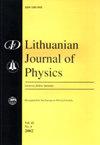Eu2+掺杂和Dy3+共掺杂SrAl4O7的27Al MAS NMR研究
IF 0.3
4区 物理与天体物理
Q4 PHYSICS, MULTIDISCIPLINARY
引用次数: 2
摘要
Eu2+掺杂的铝酸锶SrAl4O7在490 nm处呈现出蓝绿色的持续发光,而Dy3+共掺杂的SrAl4O7在475 nm处最大发光。采用固相反应法制备了未掺杂、3% eu掺杂和6% dy共掺杂的SrAl4O7样品,并采用单脉冲采集和哈恩回波脉冲序列对固态27Al MAS NMR进行了研究。结果表明,Eu2+与Dy3+离子的掺杂对SrAl4O7的体结构和局部Al环境没有影响。这意味着SrAl4O7:Eu2+与Dy3+共掺杂时,局部环境的变化不会引起发射最大值的大位移。然而,在4-和6-配位铝(20-40 ppm)信号范围内观察到的光谱特征表明,在所研究的样品中都存在一定的相缺陷,并且很可能形成了非晶/玻璃畴。值得注意的是,这样的相杂质量是无法通过标准的XRD或FTIR方法检测到的。这表明27Al MAS NMR技术是一种非常有效的监测一系列铝酸锶样品相完整性的工具。本文章由计算机程序翻译,如有差异,请以英文原文为准。
27Al MAS NMR spectroscopy study of Eu2+-doped and Dy3+-co-doped SrAl4O7
The Eu2+-doped strontium aluminate SrAl4O7 samples have shown the blue-green persistent luminescence at 490 nm while the co-doping with Dy3+ shifts the maximum of emission to 475 nm. Undoped, 3% Eu-doped and 6% Dy-co-doped SrAl4O7 samples were prepared by the solid state-reaction method and studied by the solid-state 27Al MAS NMR applying the single pulse-acquire and Hahn-echo pulse sequences. It was shown that the Eu2+ with Dy3+ ion doping did not affect the bulk structure as well as the local Al environment in SrAl4O7. This means that large shifts of the emission maximum cannot be caused by changes in the local environment upon the co-doping of SrAl4O7:Eu2+ with Dy3+. However, the spectral features observed in the range between the signals of 4- and 6-coordinated Al (20–40 ppm) indicate that certain phase imperfections are present in all studied samples, and most probably amorphous/glassy domains were formed. Note that such amount of phase impurities was not detected by standard XRD or FTIR methods. This has revealed the 27Al MAS NMR technique to be a very effective tool monitoring the phase perfectness in series of strontium aluminate samples.
求助全文
通过发布文献求助,成功后即可免费获取论文全文。
去求助
来源期刊

Lithuanian Journal of Physics
物理-物理:综合
CiteScore
0.90
自引率
16.70%
发文量
21
审稿时长
>12 weeks
期刊介绍:
The main aim of the Lithuanian Journal of Physics is to reflect the most recent advances in various fields of theoretical, experimental, and applied physics, including: mathematical and computational physics; subatomic physics; atoms and molecules; chemical physics; electrodynamics and wave processes; nonlinear and coherent optics; spectroscopy.
 求助内容:
求助内容: 应助结果提醒方式:
应助结果提醒方式:


